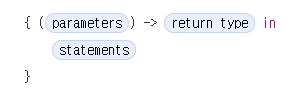Framework
Foundation
Access essential data types, collections, and operating-system services to define the base layer of functionality for your app.
Command Line Tool 등 collection, data type이 필요한 곳에 쓰임
UIKit
Construct and manage a graphical, event-driven user interface for your iOS or tvOS app.
viewController 등 인터페이스 관련 클래스, 메소드들이 있는 프레임워크
새로 찾은 것들
배열을 생성하는 여러가지 방법들
// 빈 배열 선언하기
var empty: [Int] = []
var empty2 = [Int]()
var empty3: Array<Int> = []
// 임의의 데이터가 들어가 있는 배열 만들기
var a : Array<Int> = [1,2,3,4]
var b : [Int] = [1,2,3,4]
var c = [1,2,3,4]//타입유추
var d = Array<Int>(1...4)//[1,2,3,4]
// 응용 - 2차원 배열
var arr = [[Int]](repeating: Array(repeating: 0, count: 1), count: 15)reduce
func reduce<Result>(_ initialResult: Result, _ nextPartialResult: (Result, Element) throws -> Result) rethrows -> ResultClosure
reduce, sorted를 이해하려면 Closure Expression Syntax를 이해해야 한다

밑에서 리턴하는 결과는 모두 똑같다
var names: Array<String> = ["Chris", "Alex", "Ewa", "Barry", "Danialla"]
func backward(_ s1: String, _ s2: String) -> Bool {
return s1 > s2
}
var reverseNames = names.sorted(by:backward)
var reversedNames = names.sorted(by: { (s1: String, s2: String) -> Bool in
return s1 > s2
})
var reversedNames = names.sorted(by: { s1, s2 in return s1 > s2}) // Inferring Type From context
var reversedNames = names.sorted(by: {s1, s2 in s1 > s2}) // Implicit Returns from Single-Expression Closures
var reversedNames = names.sorted(by: { $0 > $1 }) // Shorthand Argument NamesClosure 한번 더 꼼꼼하게 찾아보기!!!
stride
python에서는 range()처럼 start num > end num이 가능했었는데
swift에서는 stride로 구현해야 한다
stride(from:to:by:)
func stride<T>(from start: T, to end: T, by stride: T.Stride) -> StrideTo<T> where T : Strideablestride(from:through:by:)
func stride<T>(from start: T, through end: T, by stride: T.Stride) -> StrideThrough<T> where T : Strideablethrough는 마지막 숫자를 포함시키고 to는 포함시키지 않는다
for num in stride(from: 5, through: 1, by: -1) {
print(num)
}
// 5
// 4
// 3
// 2
// 1
for num in stride(from: 5, to: 1, by: -1) {
print(num)
}
// 5
// 4
// 3
// 2